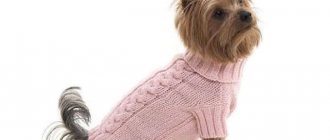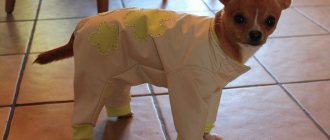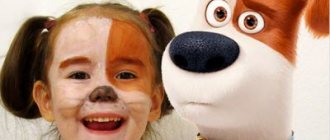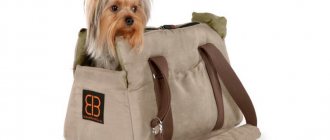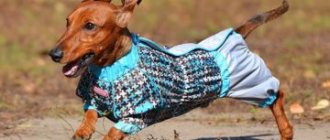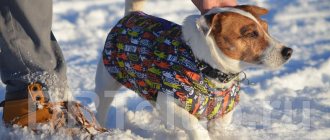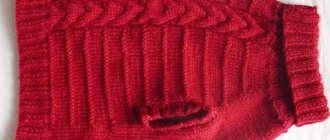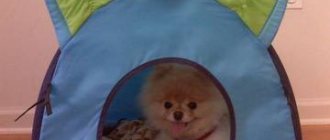With the advent and wide distribution of small smooth-haired dogs, the need arose to walk them in any weather. But decorative breeds do not tolerate cold winters, windy and humid off-seasons. Consequently, there is a need for special clothing for pets. If you go to a pet store looking for a suitable jacket for your little friend, you will be unpleasantly surprised by the high prices for this pleasure. It is much more profitable to make a sweater for dogs yourself.
You won’t have to guess about the sizes; you can measure your pet yourself and make a suitable item, constantly trying it on for the future owner.
Overalls pattern for a dachshund:
for dachshund boy
Three details in total. Two identical ones are the sides and the belly.
for dachshund girls
Crochet sweater
Crocheting a dog sweater is much easier than knitting. The main thing here is to know the size of your pet. You don't even need to use patterns. In addition, you can choose any direction for knitting, from chest to tail or vice versa. You can knit in the round, or you can knit with regular fabric.
When knitting, it is best to use a double crochet stitch. This technique is very simple to perform and does not take much time. The expansion of the product occurs by adding air loops.
- We knit a neckline of the required width.
- Let's sew it together.
- We begin to knit the main fabric, expanding it to the holes for the paws.
- Once the openings are complete, the sweater is knitted into a tube shape, tapering at the belly area.
Knitted overalls for a dachshund, diagram with explanation
Currently, clothing for dogs has become so popular that in terms of the number of models and variety of methods for its production, it is not inferior to the production of clothing for people. Overalls for a dachshund can only be sewn, but also knitted.
If you know how and love to knit, then you can apply your art to making beautiful and comfortable clothes for your beloved pet. The big advantage is that such clothes are knitted quite simply, and the color variety of the yarn will help you create for your dachshund not just comfortable clothes, but a masterpiece of design art.
To work, you will need knitting needles No. 2.5 and about 200 g of any yarn of medium thickness, which can be purchased at a special store. Perhaps you have a ball of yarn left over from a previous knitting project, or, alternatively, you can unravel some outdated item.
Overalls knitting density:
- elastic band 2*2 30 loops = 10 cm
- elastic band 1*1 30 loops = 10 cm, 35 r. = 10 cm
- + braids 66 loops = 16 cm
Knitted option
If the owner of a dachshund is easier to handle with knitting needles or a crochet hook than with a sewing machine, then it will be very easy for her to knit warm knitted clothes for her pet.
The simplest option is to make a cape in the form of a triangle or rectangle. The long side should be equal to the DS measurement (back length), the short side - OG (chest girth).
The cape can be knitted in different patterns - for insulation it is better to use vertical “braids”; a lighter version can be made with openwork.
To secure the cape, beautiful buttons, Velcro, and ties are used.
A beautiful and original sweater for a dachshund can be knitted using a special pattern.
It should be taken into account that the length of the abdomen in females is usually several centimeters longer than in males.
Here you need to take a piece of paper with the measurements taken and draw a drawing of the future warm sweater on graph paper:
- number 1 – 1/3 of the neck circumference measurement;
- 2 on the back - 2/3 of the neck circumference;
- 3 - chest length from collar to front paw;
- 4 - chest width between paws;
- 5 - back width;
- 6 — belly length (for males it is 4–5 cm shorter);
- 7 - back length;
- 8 — fixed size 6 cm (armhole height);
- 9 – 3 cm.
Knitting a sweater always starts with an elastic band on the back. For a better fit, it is made 4–5 cm wide. After this, you can give free rein to your imagination and make the product with any pattern. When all the parts of the future sweater are knitted, they are sewn together. At the neckline, the loops are cast on round knitting needles and a collar 7–10 cm high is knitted. It is better to crochet the armholes.
For seamless knitting, use the raglan sweater model
When making clothes for your dachshund yourself, you should keep in mind the characteristics of this breed:
- Dachshunds are prone to diseases of the respiratory system, so when making clothes they need to have a high collar. If the dog often goes outside in a blanket or vest, then you can wear a separately knitted shirtfront or a detachable collar.
- The skin under the tail is an extremely sensitive area for a dog, so the opening for the tail should not be too tight. The small diameter of the “window” threatens skin irritation and inflammation.
- Due to the dachshund's elongated body, its clothing should be loose - on the back, it should be located from the neck to the tail, and on the sides, it should partially cover the paws. When using ready-made patterns, additional allowances should be given on the sides of the future product.
A common option is when a dachshund sweater is knitted with raglan starting from the collar. First you need to calculate the knitting density and the number of loops for the first row. After 10–12 cm of elastic (stand-up collar), they begin the main knitting - divide the number of loops into 4 parts and knit each of them separately. On the back side, knitting in short rows should be used so that the finished product does not twist into gathers at the neck.
Raglan knitting is convenient because at all stages you can try the product on a dog and, if necessary, add or subtract loops. In addition, the length of the sweater is exactly right for a dachshund and the finished product will not need to be sewn.
What you need for a sweater and how to choose yarn
To crochet a sweater, you don't have to buy new, expensive yarn. You can take the remnants of threads from already finished previous items or unravel an unnecessary item. Stores offer a huge assortment of threads, and their choice is determined primarily by the owner’s personal tastes and financial capabilities.
You will also need a hook and sewing supplies such as scissors, needle and thread. The required accessories depend on the style of the product. You may need buttons, snaps, zippers and other elements.
Important! An interesting combination would be, for example, a dog’s blouse and the owner’s scarf, knitted from the same threads. Therefore, if you decide to buy yarn, then it is better to take it with a reserve, just in case.
Pros and cons of knitted clothes
Knitted clothes for small dogs have a number of advantages:
- it is simple and convenient;
- it can be worn at any time of the year;
- In winter, knitted items provide excellent protection from the cold and also have good ventilation;
- they are elastic, easy to put on and create comfort when worn, taking the shape of the pet’s body;
- Knitted clothing is seamless, so wool tangling and chafing are eliminated.
Among the negative aspects, one can note the fact that knitted clothes cannot be cleaned, but must be washed. During washing, clothes made of wool can “shrink”, and if the composition contains a lot of acrylic, then, on the contrary, they can stretch out.
Video: “Knitted sweater for a dog”
Masterclass with detailed step-by-step description! How to knit a sweater for a dog using an example.
Knitting pattern
A sample (about 10-12 cm) is no small thing. We cast on loops on 2 knitting needles, then transfer them to 1 knitting needle, and use the 2nd knitting needle to knit the selected pattern. It is advisable to wash the sample, perhaps the yarn will shrink, then calculate the number of loops for the pet.
After all, it is this small detail that will help you accurately calculate the required number of loops for any part of the sweater.
Knit stitch - knit one row with only knit stitches, the next with purl stitches, then repeat the rows.
Front and back stitch
All this is done before the knitting stage.
Advice! It is advisable to outline a small plan and draw a pattern, recording all the measurements and converting everything into loops.
How to take measurements from a dog
One of the important points on which the result of the work directly depends is taking measurements of the pet.
To do this, you need to take a measuring tape, a sheet of paper and a pencil. It is also necessary to find an assistant for this process. It is better if one person takes measurements and another writes them down. This way you can do it much faster without tiring your pet too much. When determining the size of the product, you need to be prepared for the fact that you will have to make some edits and adjustments during the knitting process. The measurements required for knitting will depend on the type of product chosen. It is recommended to add 1 cm to all measurements taken for ease of fit. The most frequently needed measurements are:
- Length of the product. The measurement is taken from the beginning of the collar to the place where the sweater ends;
- The sleeve length is measured and adjusted during the knitting process;
- Neck volume. You can measure it directly on your pet, or take a measurement along the length of the collar;
- The chest volume is measured 1-2 cm from the front legs. At the same time, the centimeter should lie freely so that the product does not hinder movements in the future.
Attention! It is better to take measurements when the dog is standing. The pet must keep its back and head straight. After all, this is her natural position while walking. The exception is chest circumference. To conveniently take this measurement, you need to give the command “Sit”.
Stylish knitted overalls for small breeds
We are knitting a jumpsuit that is designed for a small dog weighing 2 kilograms. Here is a pattern for a jumpsuit model.
The pattern is designed for a back length of 22 centimeters (cm), and a chest circumference of 34 cm.
- Let's start needlework with a set of 52 (P) knitting needles.
- After casting, you need to knit a fabric measuring 27 R.
- Then you need to close the knitting into a ring, and knit the dog’s clothes with a simple 1x1 elastic band.
- You need to knit 6 rows with such an elastic band, then 3 rows with stockinette stitch.
- After this, you need to close 6 loops on the openings of the sleeves.
- There should be 12 loops between the holes that will go to the front.
- Let's do 21 R for the front and 12 R for the back.
- Next, we form a ring again and knit 6 cm.
- Continuing knitting, we will close 24 sts in the lower zone and perform another 6 cm.
- Now you need to close 12 pieces in the center and tie the corners separately. In this case, you need to close 2 loops in the middle of each row until all the loops are closed.
- At this stage, you need to cast on 30 P for each hind leg, and knit 20 circular P.
- Then we close the P and crochet it around the edges.
- We also cast on 30 stitches for the front sleeves and knit 16 circular rows.
- Having finished knitting this garment, all that remains is to sew the hood, and you can try the overalls on your dog.
Step-by-step knitting a sweater for a dog with video accompaniment
The video master class shows how to knit beautiful clothes for a small dog.
Before starting work, we take the usual measurements of neck circumference, chest circumference and back length. Using these measurements, you need to draw a blouse pattern.
The pattern consists of two separate parts. The back is 25 cm wide, and the front is 9 cm. In total, this is exactly the size of the chest circumference. After making sure that the dimensions of the pattern correspond to the measurements taken, you can begin needlework.
Knitting is done with the “Honeycomb” pattern, thick mixed yarn (wool with acrylic), with knitting needles No. 6. One skein weighing 100 grams contains 140 meters of thread, and the density of the fabric is 13 P per 10 cm.
- We make a set of 36 P in accordance with the calculation, and begin to knit with the main “Honeycomb” pattern. The pattern repeat is repeated from rows 3 to 6.
- We perform the required number of vertical repeats to obtain the length from the waist to the armhole. In this case, this distance is 12 cm.
- Now we separate 4 P along the edges of the last P with a contrasting thread. These P will be used to knit the front zone of the blouse.
- We remove these Ps from the knitting needles and continue to knit only the back area, decreasing the Ps and forming the armhole line. Be sure to periodically check the shape of the armhole with the pattern.
- After decreasing, you need to make increases, and then make a neckline. Carefully follow and repeat the actions performed in the master class.
- Having finished knitting the back, we sew it and put it on the knitting needle P, which were set aside and marked with a contrasting thread.
- Having taken these Ps onto the knitting needle, we will add two Ps there, one from each edge.
- We knit the missing part of the front according to the pattern and connect the shoulder seams. We crochet the armholes of the sleeves.
Selection of materials and tools for work
In order to knit cute and bright clothes for your pet, you should first choose yarn. It should not cause allergies, but be warm and natural. Thick and fluffy threads are best. In the store you can buy cotton yarn, mohair, and linen threads. Wool with the addition of acrylic is also suitable to increase wear time. Also, clean wool will be itchy and can cause allergies. As we noted above, the yarn should be natural, since artificial yarn will be absolutely useless in cold weather, because it will not warm the dog.
Pure viscose is also not a very good option, since things will stretch and quickly lose their shape. Pure acrylic threads accumulate static electricity. Often very bright threads have an odor, which indicates that unsafe technologies were used when dyeing. So you should not buy such yarn, as your four-legged friend may experience an allergic reaction and other health problems.
If you decide to knit clothes for your pet, then you should choose the right size knitting needles or hook. Crochet can also be used to join pieces together to avoid seams, or to create a beautiful finish.
We knit a sweater for a dachshund
So, in order to knit a sweater for a dog, we will need knitting needles (2.5 or 3, or 3.5 mm), it is better, of course, if you have a set of five or more knitting needles prepared in advance - this will also be useful for other models - and , if your dachshund is no larger than a dwarf, 100 grams of yarn.
Choose your yarn color and let's get started! Knitting for dogs - knitting pattern for a sweater for dachshunds
knitting a sweater for a dachshund from the top, that is, from the neck to the tail. We cast on 54 loops (depending on the size of the dog - we measure the volume of the dachshund’s neck using the collar) and knit with an elastic band of approximately 6-8 cm. When you have knitted several rows, check whether the length is sufficient to accommodate the dachshund’s neck. This is done like this: stretch the cast-on loops on a knitting needle - approximately this way the neck of the sweater can stretch in the finished state. Estimate the size using a ruler or centimeter and compare with the neck size of your pet model. If the size seems right, continue knitting. If it seems small, it is better to undo the knitting now and re-cast on a sufficient number of loops.
After the elastic band, we switch to regular knit stitches and gradually add 1-2 loops on both sides of the knitting - if you started with 54 loops, you can increase to 60. In this way, an increase in the width of the sweater for the chest is created.
We knit each part separately; for convenience, some of the loops can be removed using a safety pin or another knitting needle. Thus, we have 3 parts: two parts - from the hole for the paws to the edge of the sweater (the place where the “zipper” will be) and the third part in the middle, between the holes for the paws. This will be the back of the sweater. Each part needs to be knitted separately to a length of approximately 5 cm (depending on the thickness of the dog’s paw, 5 cm in the case of a dwarf dachshund), after which all parts are connected. Next, we knit almost to the end without changes - about 7 cm. If your dachshund’s waist is very different in size from the chest volume, then, having finished with the cutouts for the paws, begin to gradually reduce the number of loops along the edges to the original (in our case there were 54 loops) . We finish with an elastic band, just as we started. This will allow the sweater to fit snugly and hug your dachshund's waist.
We knit the sweater until we hit the dog’s technical hole, which should be open during a walk. Therefore, the sweater for a male is shorter than for a female. So, we have a knitted sleeveless vest for a dog . Now we knit the sleeves. Due to the fact that we are knitting the simplest sweater for dogs , we will knit the sleeves separately and sew them to the sleeveless vest that we have already made. The pattern for the sleeves is a simple rectangle. We collect so many loops so that the width of the sleeve blank is approximately 10 cm (twice the length of the cutout left for the paw in the sleeveless vest). This can be approximately 25 to 35 stitches. When we fold this sleeve blank in half and sew it together, we should get a full-fledged sleeve in the shape of a cylinder just the size of the holes for the paws that we left (and we left a cut 5 cm long). The length of the sleeve depends on the length of the dog’s paws; dachshunds have short paws, and it will be enough for us to knit 5-7 cm in length. (See sweater pattern) We sew the resulting rectangles along their length to make 2 cylinders. Then we sew them to the paw hole in our sweater. All that remains is to sew on a zipper of the required length, and the knitted sweater for the dog is ready!
Did you like the article? Subscribe to the channel to stay up to date with the most interesting materials
Source
Variety of warm clothes
Considering the characteristics of the breed, the set of things for your pet will be solid. For a Chihuahua, clothing is simply necessary, as it protects the dog from cold and wind. Even if it gets a little cold outside, your four-legged friend will need overalls that won't get wet in rainy weather. This type of clothing is very popular for miniature pets, as it is comfortable and practical.
You can make your own windbreaker or raincoat, and when it gets cold, you can wear warm knitted clothes (for example, a sweater or pullover).
When you are replenishing your pet’s wardrobe, regardless of whether you buy things from a pet store or knit them yourself, they should not only be warm, but also as comfortable as possible for the animal, so as not to limit the pet’s movements.
If a boy's blouse is open on the tummy, then for a girl, clothing is selected that completely covers this area. It is also worth taking care of shoes so that the Chihuahua does not injure its paws during a walk.
Knitting a dress for a dog
We start knitting for animals by making a red jumpsuit dress for a small dog using knitting needles.
To knit this cute jumpsuit, you will need 100 grams (g) of red acrylic yarn (280 m/100 g), and 20 grams of lilac yarn. We knit a dog dress using circular knitting needles No. 3 and crochet No. 3.
The needlework is done in three different patterns.
- The first pattern is a regular stockinette stitch.
- In addition, we perform an openwork pattern according to scheme 1, which shows only odd facial rows (P). In this case, all purl stitches are knitted according to the pattern. The vertical repeat of scheme 1 is two R.
- The third fantasy pattern is made according to pattern 2. On it, even purl rows are also knitted according to the pattern.
- We knit a jumpsuit for a dog, starting with a set of 30 loops (P), and making 8 cm of the pattern in stockinette stitch.
- Then we switch to a fantasy pattern, knitting two vertical repeats.
- After this we will return to knitting in stockinette stitch again. You need to knit 19 cm from the cast-on edge, and then make two large loops to thread the dog’s front legs through.
- We knit a fabric measuring 25 cm, after which we close the loops of the last R.
- At the end of the needlework, you need to crochet the outer edge with two rows of single crochets.
- Then we will make a set of large loops from the edges, and knit 4 cm in stockinette stitch in circular rows.
- We knit all the other sleeves for the dog’s paws in the same way.
- Having knitted 8 cm from the cast-on row, we will cast on loops with lilac threads and knit a 3 cm frill, with an openwork pattern according to scheme 1.
